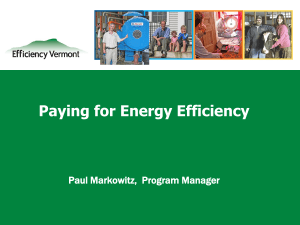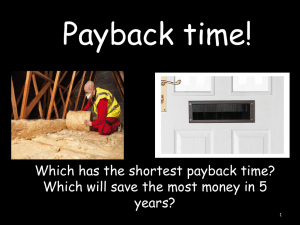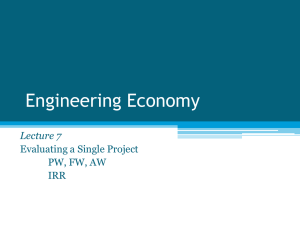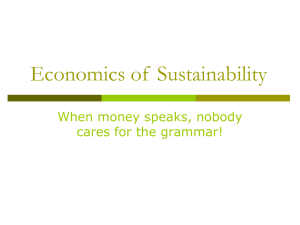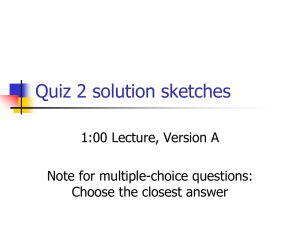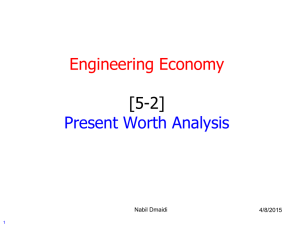443_CHP4 - X İngilizce
advertisement
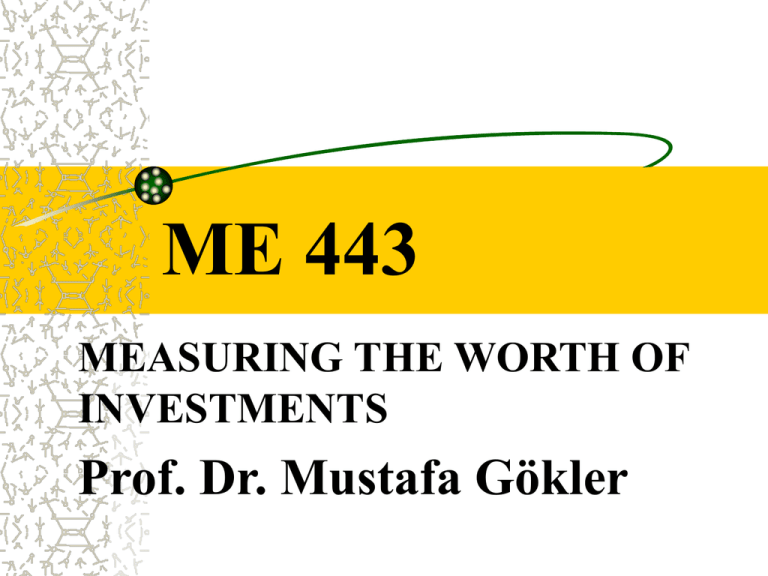
ME 443 MEASURING THE WORTH OF INVESTMENTS Prof. Dr. Mustafa Gökler INTRODUCTION Engineers and systems analysts solve problems by formulating and analyzing the problem, generating a number of feasible solutions (alternatives) to the problem, comparing the investment alternatives, selecting the preferred solution, and implementing the solution. INTRODUCTION A number of methods and criteria for measuring the worth of investments will be discussed in this chapter. These forms the basis for techniques used in the next chapter to compare alternative investments and select those preferred from the economic point of view. INTRODUCTION Where compound interest calculations are used, the measures of investment worth are referred to as discounted cash flow (DCF) measures; the methods used to compute the values of investment worth are called discounted cash flow methods. INTRODUCTION The compound interest rate used is variously referred to as a minimum attractive rate of return (MARR), required rate of return, return on investment, and discount rate. METHODS OF MEASURING INVESTMENT WORTH 1. Present worth method (PW). 2. Annual worth method (AW). 3. Future worth method (FW). 4. Internal rate of return method (IRR). 5. External rate of return method (ERR). 6. Savings/investment ratio method (SIR). 7. Payback period method (PBP). 8. Capitalized worth method (CW). METHODS OF MEASURING INVESTMENT WORTH With the exception of the payback period and capitalized worth methods all of the measures listed are equivalent methods of measuring investment worth. Hence, applying each of the first six measures of merit to the same investment alternative will yield the same recommendation. PRESENT WORTH METHOD Present Worth (PW) method converts all cash flows to a single sum equivalent at time zero using i = MARR. Ajt : Net cash flow for investment j at the end of period t ANNUAL WORTH METHOD Annual Worth (AW) method converts all cash flows to an equivalent uniform annual series of cash flows over the planning horizon using i = MARR ANNUAL WORTH METHOD FUTURE WORTH METHOD Future Worth (FW) method converts all cash flows to a single sum equivalent at the end of the planning horizon using i = MARR. FUTURE WORTH METHOD EXAMPLE A pressure vessel was purchased for $16,000, kept for 5 years, and sold for $3000. Annual operating and maintenance costs were $4000. Using a 12% minimum attractive rate of return, what was the present worth for the investment? EXAMPLE (PW) PW (12%) = - $16,000 - $4000(P|A 12,5) + $3000(P|F 12,5) = -$16,000 - $4000(3.6048) + $3000(0.5674) = -$28,717 EXAMPLE (AW) AW (12%) = - $16,000(A|P 12,5)-$4000 + $3000(A|F 12,5) = -$16,000(.2774) - $4000 + $3000(.1574) = -7966.20/year EXAMPLE (AW) AW (12%) = PW(12%) (A|P 12,5) AW (12%) = (-$28,717)(A|P 12,5) = (-$28,717)(.2774) = - $7966.10/year EXAMPLE (FW) FW (12%) = - $16,000(F|P 12,5) - $ 4000(F|A 12,5)+$ 3000 = -$16,000(1.7613) - $4000(6.3528) + $ 3000 = - $ 50608 EXAMPLE (FW) FW (12%) = PW(12%) (F|P 12,5) AW (12%) = (-$28,717)(1.7623) = -$ 50608 INTERNAL RATE OF RETURN METHOD Internal Rate of Return (IRR) method determines the interest rate that yields a future worth (or present worth or annual worth) of zero. INTERNAL RATE OF RETURN METHOD Ajt : Net cash flow for investment j in period t ij* : Internal rate of return IRR INTERNAL RATE OF RETURN METHOD INTERNAL RATE OF RETURN METHOD Rjt : Receipts Cjt : Cost(Disbursments) rt : reinvestment rate for positive cash flows occuring in period t i’ : the rate of return for negative cash flows In IRR Method rt = i’ EXAMPLE An investment of $ 10 000 will be made in a project that will produce an uniform annual revenue of $ 5 310 for 5 years and then has a salvage value of $ 2 000. Annual disbursment will be $ 3 000 for operation and maintenance cost. What is IRR ? EXAMPLE (5310-3000) (P\A i,5) + 2000 (P\F i,5)- 10 000 = 0 2310 [(1+i)5-1]/[i(1+i)5]+2000 (1+i)-5-10000=0 IRR can be found by trial-and-error. IRR = i = 10 % 2310(3.7908)+2000(0.6209) – 10000 = 0 EXTERNAL RATE OF RETURN METHOD External Rate of Return (ERR) method determines the interest rate that yields a future worth of zero, explicitly assuming reinvestment of recovered funds at the MARR. EXTERNAL RATE OF RETURN METHOD Rjt : Receipts Cjt : Cost(Disbursments) rt : the reinvestment rate for positive cash flows occuring in period t rt = MARR i’ : the external rate of return (for negative cash flows) EXAMPLE An investment of $ 10 000 will be made in a project that will produce an uniform annual revenue of $ 5 310 for 5 years and then has a salvage value of $ 2 000. Annual disbursment will be $ 3 000 for operation and maintenance cost. MARR = 10% What is ERR ? EXAMPLE (5310-3000) (F\A 10,5) + 2000 - 10 000 (F\P i’,5)= 0 2310 (6.1051)+2000 -10000 (1+i’) 5 =0 16102.781 = 10 000 (1+i’) 5 (1+i’) 5 = 1.6102781 ERR= i’ = 10 % i’ = 10 % EXAMPLE (IRR) Multiple Roots :As an illustration of a cash flow profile having multiple roots, consider the data given in Table. The future worth of the cash flow series will be zero using a 20, 40, or 50 % interest rate. Cash Flow Profile EOY CF 0 - 1000 1 4100 2 - 5580 3 2520 EXAMPLE FW1(20%)= -1000(1.2)3+ 4100 (1.2)2 -5580(1.2) +2520 = 0 FW1(40%)= -1000(1.4)3+ 4100 (1.4)2 -5580(1.4) +2520 = 0 FW1(50%)= -1000(1.5)3+ 4100 (1.5)2 -5580(1.5) +2520 = 0 By factoring the future worth of third-degree polynomial FWi(i)= -1000(1.2-x) (1.4-x) (1.5-x) where x= (1+i) EXAMPE SAVINGS/INVESTMENT RATIO METHOD Savings/Investment Ratio(SIR) (or Benefit/Cost) method determines the ratio of the present worth of savings to the present worth of the investment. SAVINGS/INVESTMENT RATIO METHOD SAVINGS/INVESTMENT RATIO METHOD EXAMPLE Cash Flow Profile EOY CF 0 - 10000 1 2525 2 2525 3 2525 4 3840 5 3840 6 3840 Find SIR EXAMPLE =2525 (P\A) 15,3) +3840(P\A) 15,3) (P\F) 15,3) = 2525(2.2832)+3840(2.2832)(0.6575) = 11 529.70 = - 10 000 = -10 000 + 11529.70 = 1529.70 EXAMPLE Method I : SIR1 = Receipts / Costs SIR 1 (15%) = $11,529.70 = 1.15297 $10,000 Method II : SIR1 = Net cash flows / Costs SIR1(15%) =$1529.70 / $10000 = 0.15297 PAYBACK PERIOD METHOD Payback Period (PBP) method determines how long at a zero interest rate it will take to recover the initial investment. PAYBACK PERIOD METHOD A number of variations of the payback or payout method have been used by different organizations. The payback period might be defined as the smallest value of mj in the following formula, Also, the payback period may be noninteger, assuming cash flows are uniformly distributed throughout the year. PAYBACK PERIOD METHOD In the payback period method, the timing of cash flows and the duration of the project are ignored. The payback period method is recommended as a secondary method of measuring investment worth. In particular, it is suggested that the payback period method be used in addition to a method based on the time value of money. EXAMPLE Cash Flow Profile EOY CF 0 - 10000 1 2525 2 2525 3 2525 4 3840 5 3840 6 3840 Find Payback Period PAYBACK PERIOD METHOD 2525+2525+2525=7575 < C10= 10000 2525+2525+2525+3840=11415 > C10= 10000 Consequently, m equals 4, indicating that 4 years are required to pay back the original investment. CAPITALIZED WORTH METHOD Capitalized Worth (CW) method determines the single sum at time zero that is equivalent at i = MARR to a cash flow pattern that continues indefinitely. CAPITALIZED WORTH CAPITALIZED WORTH METHOD A=Pi P=A/i P is a present value that will pay out equal payments of size A indefinitely, if the interest rate per period is i. The present value P is termed the capitalized worth of A, the size of each of the perpetual payments. EXAMPLE (4.12) What deposit at t = 0 into a fund paying 9.5 % annually is required in order to pay out $5000 each year forever? P = A / i = 5000/ 0.095 = 52631.58 EXAMPLE (4.13) Project ABC consists of the following requirements: 1. A $50,000 first cost at t = 0. 2. A $5000 expense every year. 3. A $25,000 expense every third year forever, with the first expense occurring at t = 3. What is the capitalized cost of Project ABC if i = 15% annually? EXAMPLE (4.13) CW1 = 50 000 CW2 = 5 000 / 0.15 = 33 333 i = [ ( 1+0.15)3-1]=0.5209 CW3 = 25000/0.5209 = 47996.16 EXAMPLE (4.13) The capitalized cost of Project ABC is computed as follows: 1. Capitalized cost of $50,000 first cost 50000 =$ 2. Capitalized cost of $5000 every year= $5000/0.15 = $ 33333 3. Capitalized cost of $25,000 every third year 47996.16 TOTAL CAPITALIZED COST =$ =$131329.16 CAPITAL RECOVERY FORMULA Figure illustrates an investment of $P in an asset having a life of n years and disposed of for a salvage value of $F. The capital recovery cost is a uniform annual amount defined as CR = P (A\P i,n)- F(A\F i,n) EXAMPLE A stand-alone computer is purchased for P = $82,000, has a service life of n = 7 years, and a salvage value of F = $5000. At an interest rate of 15%, the capital recovery cost is CR = 82000 (A\P 15,7)- 5000(A\F 15,7) = 82000(0.2404) - 5000(0.0904) = 19260.80/year

